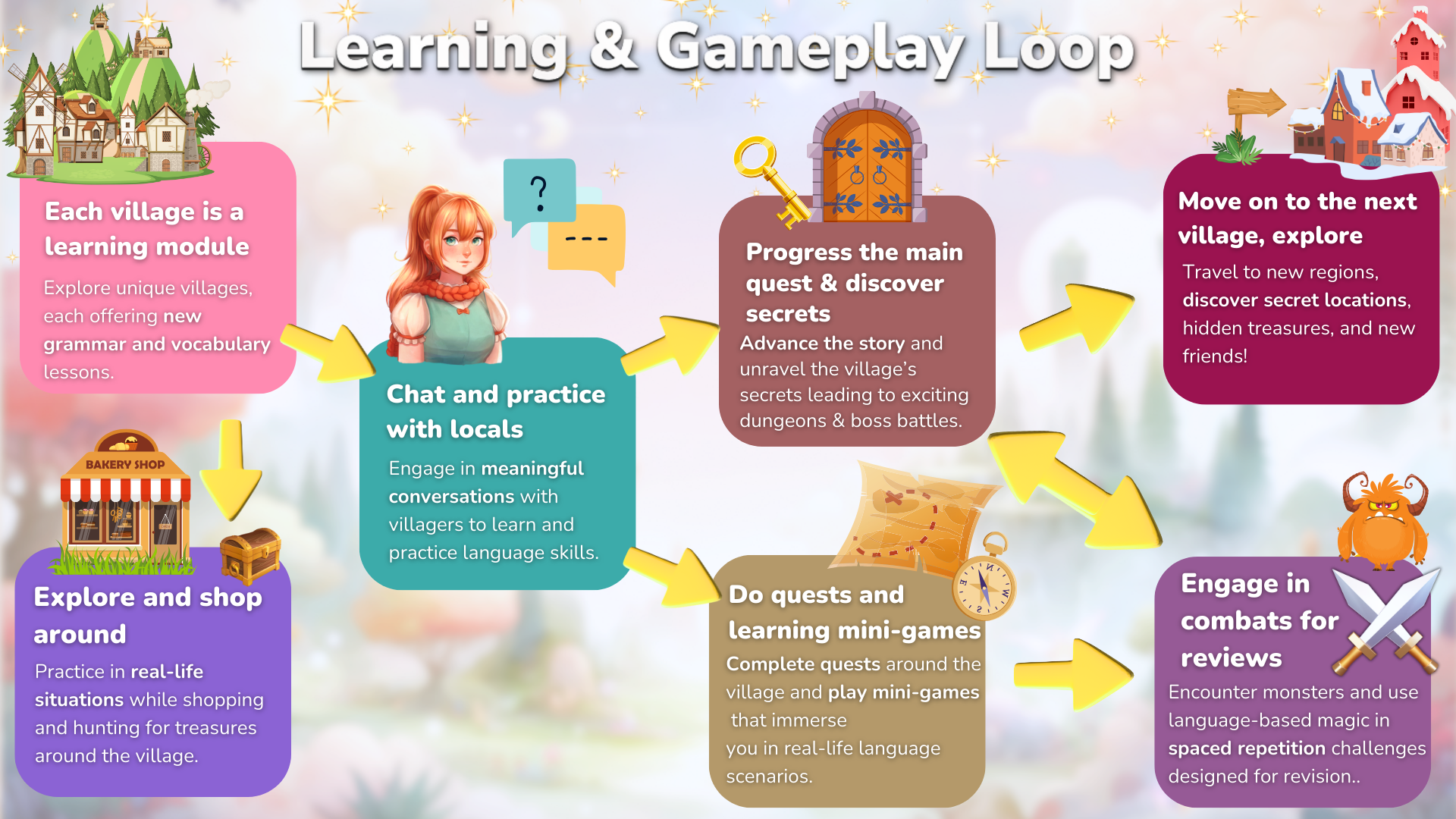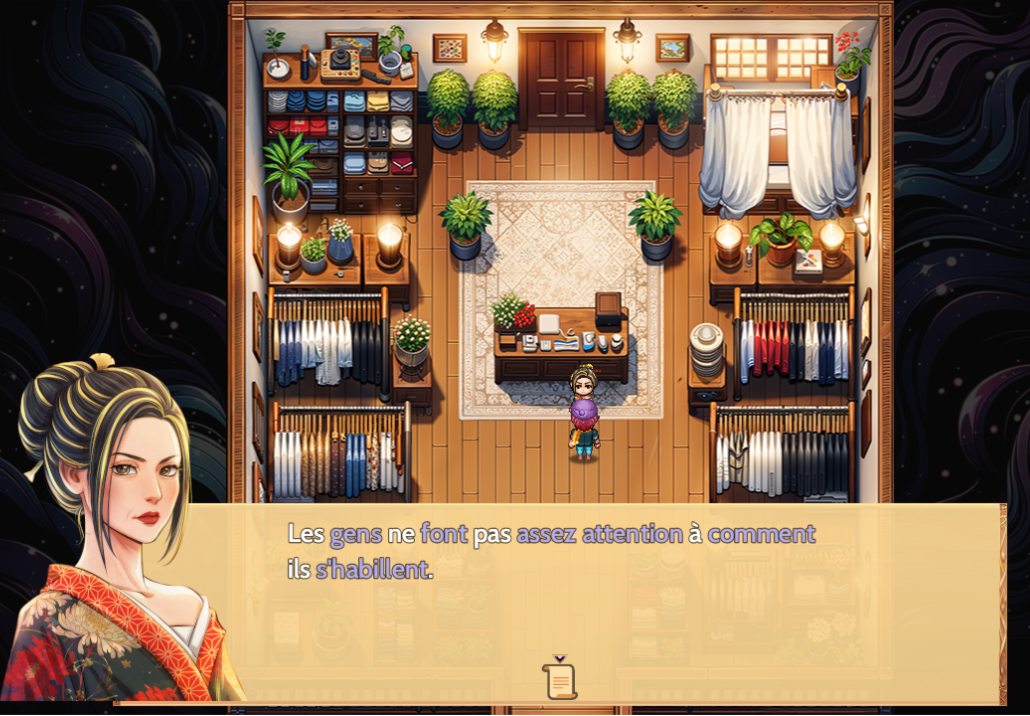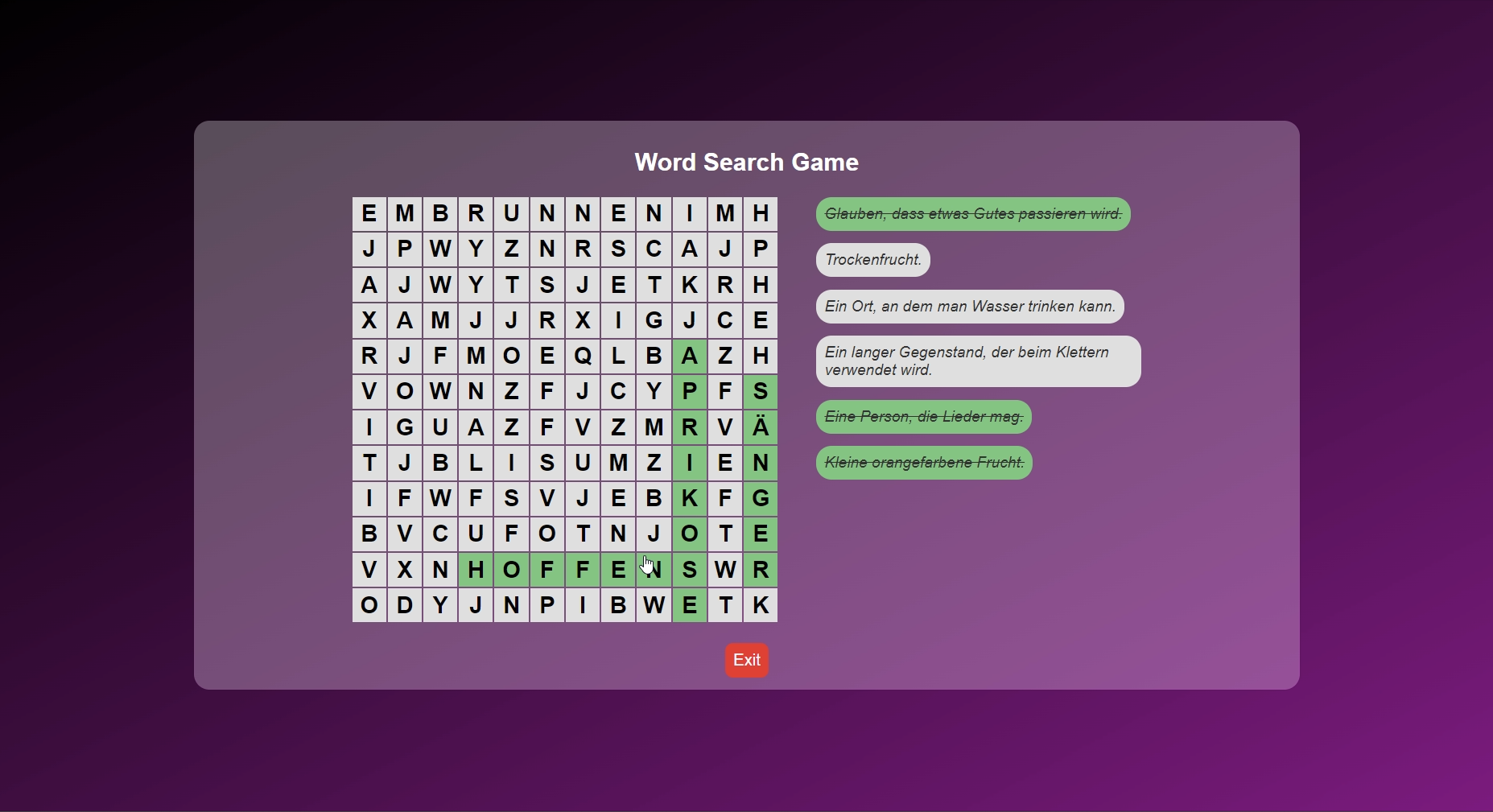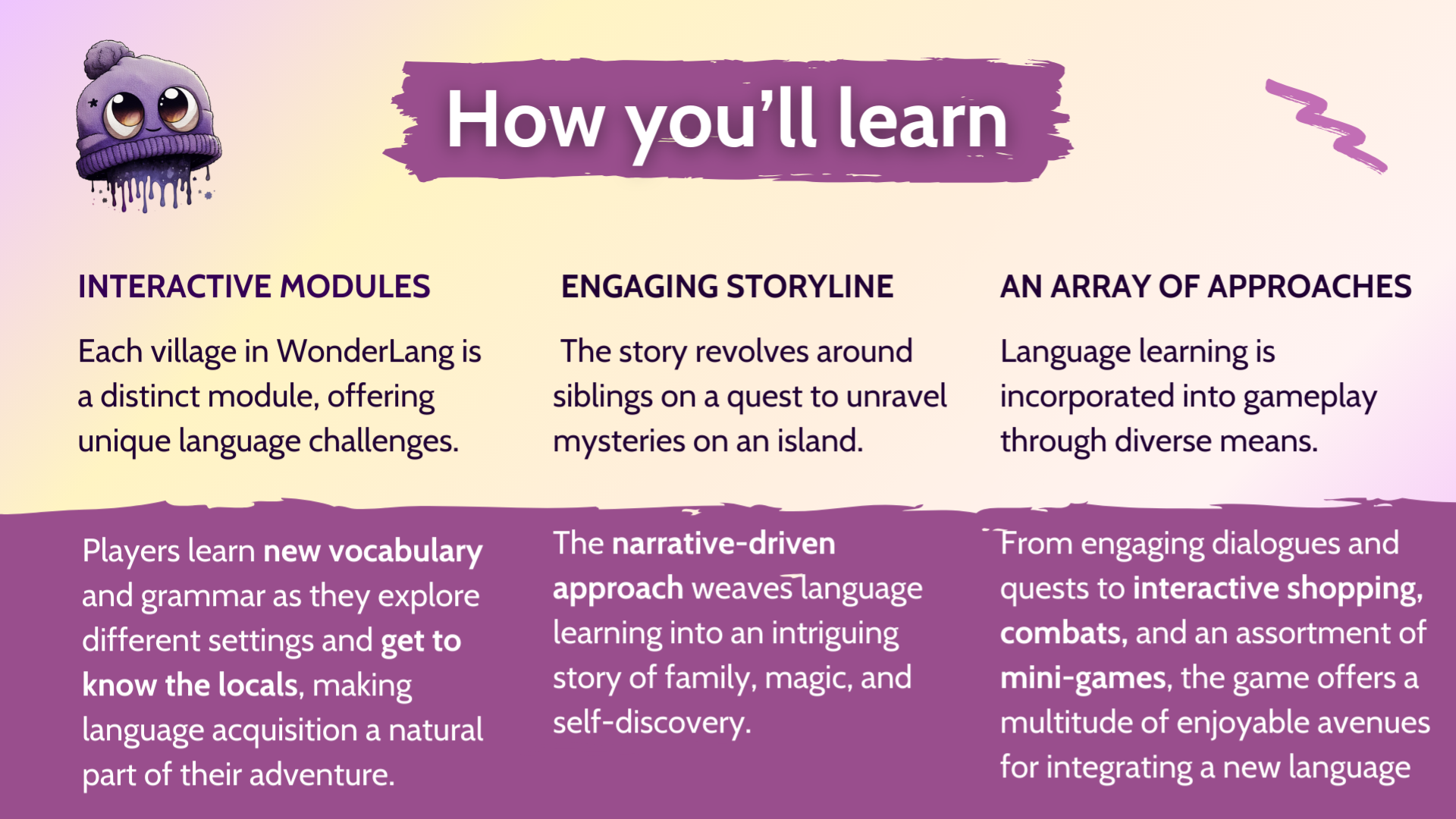Features
Gameplay and Learning Experience
Live the Language
WonderLang is built around a simple idea: if you act in the language, you will remember it. This first page focuses on the dialogue system, study tools, and learner‑friendly options that turn every conversation into progress.
Learn by Doing
Content‑Based Learning (CBI) puts you inside a story‑rich JRPG. Quests, puzzles and NPC chats are written to introduce vocabulary in real context, not as isolated word lists. You progress in the language by progressing in the adventure, just like the first time you learned English from your favourite import RPGs.


Level‑Ups That Matter
Your character does not grind fake XP. Stats rise only when you demonstrate genuine language gains. More words mastered equals more power. Real‑life progress drives in‑game strength.
Quests That Teach
Real‑Life Scenarios: shop for groceries, book hotels, visit a doctor.
Classic RPG Quests: explore dungeons, solve magical puzzles, hunt monsters.
Each objective doubles as targeted practice for everyday language.
Real Explanations, When You Need Them
Grammar rules and idioms are explained in context, right when they appear. WonderLang gives clear, simple explanations during dialogues, with helpful examples. It feels like having a language tutor guiding you as you play.
Immersive Dialogue System
The dialogue system turns every conversation into progress. When characters speak you get:
| Voice replay | Tap a button to hear any line again at normal or half speed. Perfect for catching tricky sounds. |
| Sentence breakdown | See the verb, tense, particles or prepositions used. Quick grammar pop‑ups explain the structure. |
| Word & idiom lookup | Click any word or expression to view the translation, pronounciation, and audio sample. |
| Message log | Scroll back through earlier lines any time so nothing is missed |
| Memo Pad | Jot down your own notes or write new words for later |
During your hero’s replies you practise production, not just reading:
-
Type‑with‑Hints – the game shows a few anchor letters, you fill the rest.
-
Word‑Order Puzzles – drag words into the correct sequence.
-
Speak‑to‑Advance – on Windows you can pronounce the full line and let speech recognition judge it.
An optional Easy Mode can give you more hints and you can reveal answers after several attempts so you never get stuck.
On‑screen Keyboards in two flavours: full layout or a slim row of special characters. All special characters are also mapped to the number keys so you can type é, ñ, ß, or any other useful character instantly.
Korean and Japanese versions include different types of visual keyboards and input mappings, so you can choose the typing method that works best for you.

Review Sessions After Every Scene
At the end of each conversation you enter a quick recap:
-
Flashcards show all new vocabulary with pictures or example sentences.
-
Mini‑quiz asks you to transcribe key lines you just heard.
-
Spaced Repetition queue schedules the same words for later battles, guaranteeing long‑term retention.
Master Words Through Battle
Every enemy encounter is a Spaced Repetition Battle. Answer vocabulary, listening or spelling prompts; correct answers power your attacks, while misses give the monster a turn. The timing is tuned to the optimal forgetting curve so words stick long‑term.
Combat Toolbox
-
Vocabulary Attacks – pick the right translation, match pairs or type what you hear (3 difficulty tiers).
-
Conjugation Strikes – supply the correct verb form in present, past or future tenses.
-
Adjective Stones – slot up to two adjectives such as big or warm to boost damage, cut MP cost or add elemental effects (heat, cold, light, dark). Inspired by the chip system in NieR: Automata.

Tune the Challenge
- Combat Length Multiplier – Scales enemy HP so reviews last 30 seconds or 3 minutes, your call.
- Random Encounter Toggle – Reduce or switch off roaming monsters if you want pure story flow.

A Variety of Learning Approaches
Beyond dialogue and combat, WonderLang offers many ways to reinforce your target language through varied and engaging formats:
-
Lore Reading – Dive into longer, level-adjusted texts that expand the world of WonderLang while developing your reading comprehension.
-
Listening Challenges – Some quests require you to follow audio-only dialogue, helping you sharpen your listening skills without visual cues.
-
Unassisted Cutscenes – Watch cinematic scenes with no subtitles or hints, then answer questions to test how much you understood.
-
Board Game Sections – Explore game boards filled with vocabulary and grammar challenges. Roll the dice, pick a path, and tackle each mini-quest to move forward.
These varied formats ensure you're practicing all key language skills (reading, listening, understanding, and producing) in fresh, exciting ways.

Mini‑Game Galore
Jump into one of many short games a change of pace. A few examples include:
-
Memory Flip – Match word pairs with images to reinforce vocabulary.
-
Crosswords & Sudoku – Solve grids with clues and answers in your target language.
-
Conjugation Battleship – Conjugate verbs correctly to launch attacks and sink your opponent’s fleet.
-
Hangman, Word Puzzles, and More – Inspired by classic board games and word-based game shows, designed to make learning playful.
These quick bursts make extra review feel like a fun break, not like studying.
Three Entry Paths
| Mode | CEFR / JLPT / TOPIK equivalence | What changes in the game |
|---|---|---|
| Very Beginner | Pre‑A1 • JLPT pre‑N5 • TOPIK pre‑1 | Extra review checkpoints inside every chapter, mandatory early quests. |
| A1 | A1 • JLPT N5 • TOPIK 1 | Skips the first review‑heavy segments, makes chapter 1 side quests fully optional. |
| A2 | A2 • JLPT N4 • TOPIK 2 | Skips more review‑heavy segments, makes chapter 1 & 2 side quests fully optional. |
The Korean and Japanese versions add a prologue chapter that teaches Hangul or Kana step by step before the main story begins.
Why It Works
-
Learning happens in context, not in flashcard isolation.
-
Immediate pronunciation, grammar and meaning support keeps you moving forward.
-
Tailor the play style to feel challenged but never overwhelmed.
Frequent micro‑reviews lock new phrases in memory before they fade.
A variety of approaches to never feel bored
